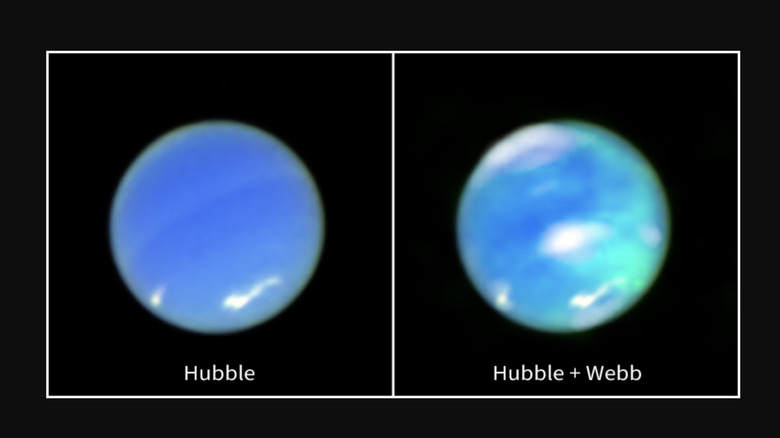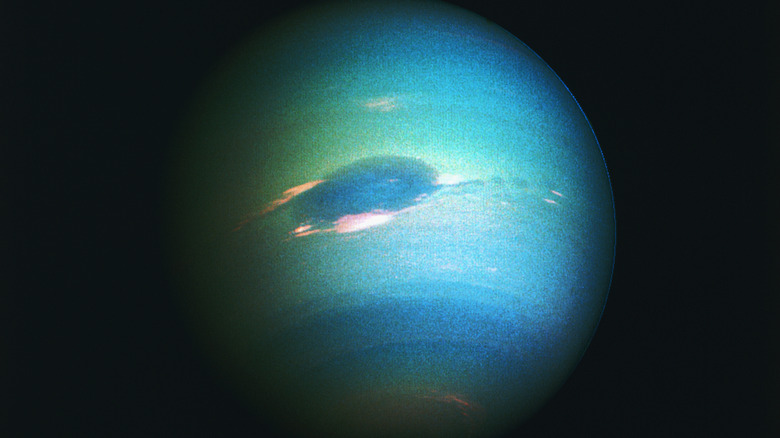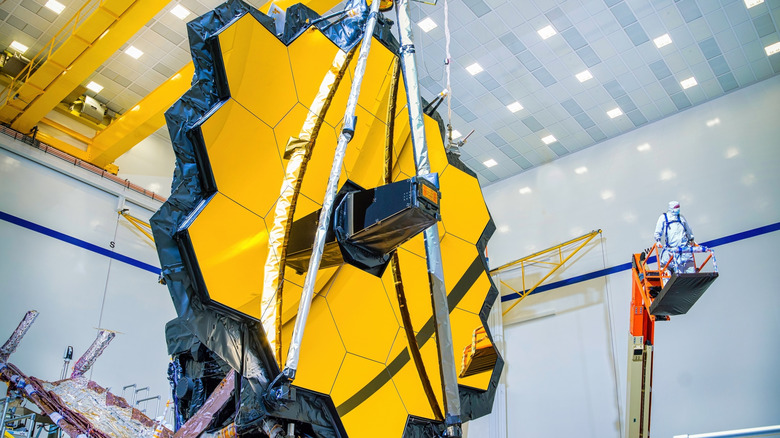The Stunning Glow Caught By The James Webb Space Telescope While Studying Neptune
Neptune has always been the solar system's mysterious outlier — a frigid, distant ice giant spinning in the dark nearly 3 billion miles from the Sun. But thanks to NASA's James Webb Space Telescope (JWST), we're seeing this alien world in an entirely new light. In the summer of 2023, JWST captured Neptune's auroras glowing across the planet's upper atmosphere, the first time these vibrant emissions have ever been seen in infrared. The results, which were recently published in a study in the journal Nature Astronomy, provide a new window into the gas giant's nature like never before.
Far from the familiar, relatively featureless cobalt orb seen in the spectrum of visible light, Neptune appears in Webb's infrared imagery as a dynamic, glowing planet. Bright patchy clouds and shimmering arcs of infrared light trace energetic auroral activity as they streak across its atmosphere. It's a hauntingly beautiful portrait and a powerful scientific breakthrough for a planet that remains enigmatic to science.
Auroral activity is nothing new on Earth, but scientists have long been interested in what auroras look like on other planets in the solar system. Compared to planets like Jupiter or Saturn, little is known about Neptune's auroras, but this discovery changes that. The cause of this distant planet's light show and what it reveals about Neptune's internal workings are still being studied, but they hint at complexities researchers are finally getting the chance to start unraveling.
What Neptune's auroras tell us
The auroras captured on Neptune aren't just pretty lights; they offer a window into the planet's wild magnetic and atmospheric behavior. JWST took its readings in June 2023 using its Near-Infrared Spectrograph, which separates light into a spectrum that provides scientists valuable insights into an object's chemical composition, mass, and other properties. Using this tool, researchers measured the temperature and the chemical composition of Neptune's ionosphere, the region of a planet where auroras occur. In a first, scientists discovered what's known as an emission line — a defined line in a spectrum resulting from an emission of light — coming from the planet.
This line indicated the presence of trihydrogen cation (H3+), an ion molecule that absorbs and then releases energy in infrared wavelengths when sunlight hits it (on Earth, sunlight generally interacts with oxygen and nitrogen gases to form our auroras). Because of similar observations of H3+ on Jupiter and Saturn, scientists expected to see such auroras on Neptune, but they finally have confirmation of this fact. "It turns out, actually imaging the auroral activity on Neptune was only possible with Webb's near-infrared sensitivity," study lead author Henrik Melin said in a press release.
But what sets Neptune apart from the other gas giants is the fact that its auroras are not limited to occurring at its poles. The planet is putting on its light show at its geographic mid-latitudes, which would be like seeing an auroral display on Earth from Central America. This unique display owes its existence to Neptune's equally unique magnetic field, which sits on a 47-degree tilt from the planet's rotational poles. Charged particles from the Sun go where the magnetic field dictates, resulting in the bright blue light display over Neptune's broadside.
Neptune's atmosphere is cooling down
Apart from revealing the composition of Neptune's ionosphere, JWST has uncovered surprising trends in the planet's atmospheric temperature. The recent study suggests that the planet's upper atmosphere has experienced significant cooling since 1989 when the Voyager 2 spacecraft made its historic flyby. Temperatures have dropped so sharply that the upper atmosphere is now nearly half as warm as it was over 30 years ago.
That temperature shift matters. Scientists believe the drop has muted Neptune's auroral activity, possibly explaining why it has remained undetected until now. But with the capabilities of JWST, researchers have a new tool to monitor Neptune's ionosphere across the sun's 11-year magnetic cycle — a period during which solar activity fluctuates and the sun's magnetic field undergoes a complete reversal.
Every bit of data helps. On Earth, researchers have studied auroras so closely that we can now explain every color of northern and southern lights on our planet, as well as the different types of auroras that exist. Studying auroras on Earth helps us predict geomagnetic storms, but it also tells us more about the nature of how our planet interacts with our star. Neptune is no different; studying its auroras advances our understanding of the broader mechanisms governing planetary atmospheres across the solar system.


